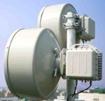Sagittar PDH 5.8GHz License-exempt Band Microwave Radios
Sagittar PDH 5.8GHz License-exempt Band Digital Microwave Radios
These Digital Microwave Radios (DMR) operate in the 5.8GHz ISM band using 20dBm (Standard Power) or 27dBm (High Power).
Sagittar supplies a complete radio link in one 32kg box. The shipping box includes 2 x Indoor Units (IDU), 2 x Outdoor Units (ODU) and installation materials. Installation materials include coaxial "flyleads" for connections within the equipment container. Additionally, there is an earthing kit for both sides of the digital microwave radio link.
The IDU connects to the ODU using IF cable. Often, installers put the IDU inside an equipment container. The installers mount the ODU on a mast or tower.
Often, the installation company sources IF cable in-country. Sagittar can also supply the IF cable. Please request the cable lengths needed per side.
Installers use IF cable such as RG213 (or an equivalent 50 Ohm coaxial cable). RG213 allows up to 300m distance between an Indoor and Outdoor Unit. The length of the "IF Cable" at each site varies and depends on the distance between the Indoor Unit (IDU) and Outdoor Unit (ODU).
If the area is lightning-prone, you use an "entry panel" lightning protector. The lightning protector passes though the "entry panel" of the equipment container. Installers earth the metal entry panel. If there is no earthed entry panel, one uses a cable earthing kit. The lightning protector prevents damage to equipment within the container. Lightning-induced pulses are "diverted to earth".
The Indoor unit input voltage is -48VDC. The IDU will in-turn provide power to the Outdoor unit through a "IF" coaxial cable that interconnects the IDU and the ODU.
The Indoor Units use Service Card (SC) modules. The photo below shows a FESC (Fast Ethernet) on the left and an 8E1SC on the right.
There are four SC slots on the left-hand-side of the IDU. The IDUs can house up to four (4) Service Cards.
A combination of 8E1SC and FESCs fits in the Service Card slots of an IDU.
An 8E1SC will allow transmission of 8E1s.
A FESC has 2 FE (Fast Ethernet) ports that work in an Ethernet switch mode.
Indoor Unit showing Service Card and Modem Card slots
The Indoor Unit has two "modem slots" on the right-hand-side: QPSK or 16QAM modem cards are used.
If required, 2 modem cards get fitted to allow 1+1 Hot Standby Protection or 1+1 Diversity.
If there are two modem cards in the IDU, each modem card can be independently powered to allow DC-power redundancy.
Each IDU has an Ethernet NMS (Network Management System) port. The NMS port allows management of microwave radio links using Out-of-Band (OOB) SNMP. OOB SNMP ensures extra network security.
Sagittar can supply a NMS solution. Sagittar has customized Castlerock's SNMPc application software. The software shows realtime status of remote IDU front panel LEDs for a network of radio terminals. Please email sales@sagittar.com if you need such a solution.
Please refer to this link for product technical specifications: Technical Specifications.
Please refer to this link to see a table of throughput speeds. Capacity (throughput speed) depends on channel bandwidth (MHz) and the choice of modulation: Data Speed Table.
FAQ 1: What are the channel and capacities options?
Capacity shown in brackets is "per-direction" Ethernet throughput. So, a 7MHz channel microwave radio link will have 6 channel options and transfer 8Mbps/8Mbps with QPSK modems or 17Mbps/17Mbps with 16QAM modems. 17Mbps/17Mbps infers FDD (Frequency Division Duplex).
| Bandwidth | Channels | QPSK | 16QAM |
| 3.5MHz | 12 | 2E1 (4Mbps/4Mbps) | |
| 7MHz | 6 | 4E1 (8Mbps/8Mbps) | 8E1 (17Mbps/17Mbps) |
| 14MHz | 3 | 8E1 (17Mbps/17Mbps) | 16E1 (34Mbps/34Mbps) |
| 28MHz | 1 | 16E1 (34Mbps/34Mbps) | 32E1 (68Mbps/68Mbps) |
e.g. 17 Mbps / 17 Mbps indicates 17 Mbps in BOTH directions.
FAQ 2: Why work with QPSK and 16QAM and not 64QAM or 128QAM in the 5.8GHz ISM Band?
5.8GHz is a shared band.
QPSK and 16QAM are more robust modulation choices for the 5.8GHz ISM band.
An attempt to work with 64QAM or 128QAM modems means Carrier-to-Interference (C/I) susceptibility of -26dB or -29dB respectively. This means that a 128QAM carrier would be sensitive to interferer receive levels 29dB lower than the received carrier's power level.
We recommend using slower-speed links in the ISM band. These links are more robust, using QPSK or 16QAM modulation. This way, the links are less susceptible to bit errors. The most robust solution choice uses QPSK modems.
FAQ 3: Packing and Shipping Information
Please refer to this link to review digital microwave link packaging information: Packing information and Purchasing Guidelines.
Sagittar ships links by air freight.
Sagittar ships antennas by sea freight, unless the antennas are small enough to ship using air freight.
Photographs
Please refer to this link for Digital Microwave Radio link component photographs: Photographs.
Contact information
If you have any questions, please email your questions to sales@sagittar.com


